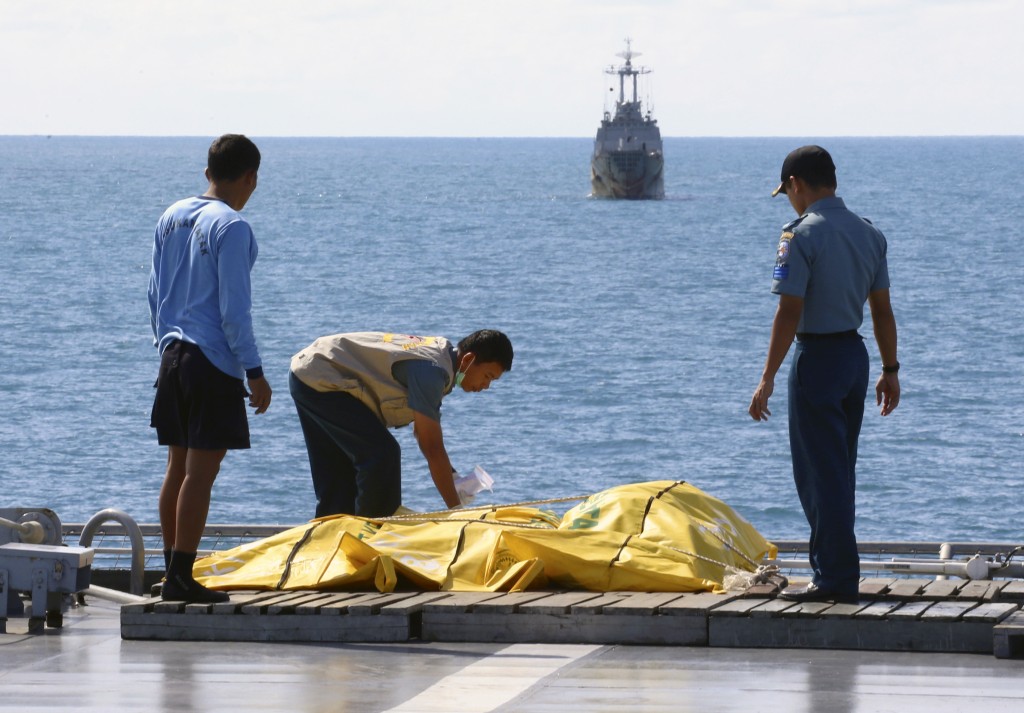- California Assembly OKs highest minimum wage in nation
- S. Korea unveils first graphic cigarette warnings
- US joins with South Korea, Japan in bid to deter North Korea
- LPGA golfer Chun In-gee finally back in action
- S. Korea won’t be top seed in final World Cup qualification round
- US men’s soccer misses 2nd straight Olympics
- US back on track in qualifying with 4-0 win over Guatemala
- High-intensity workout injuries spawn cottage industry
- CDC expands range of Zika mosquitoes into parts of Northeast
- Who knew? ‘The Walking Dead’ is helping families connect
Divers enter crashed AirAsia plane’s fuselage for first time

Crew members inspect bags containing bodies believed to be victims of AirAsia Flight 8501 on the deck of Indonesian Navy ship KRI Banda Aceh, on the Java Sea, Indonesia, Friday, Jan. 23, 2015. The ill-fated jetliner plunged into the java Sea while en route from Surabaya, Indonesia’s second-largest city, to Singapore last month. (AP Photo/Natanael Pohan)
PANGKALAN BUN, Indonesia (AP) — For the first time, Indonesian divers were able Friday to enter the fuselage of the AirAsia jetliner that crashed last month into the Java Sea and retrieved six bodies, an official said.
The operations chief at the National Search and Rescue Agency, Suryadi Bambang Supriyadi, said the divers spotted some more bodies inside the fuselage.
“Today we have evacuated six bodies from inside the fuselage,” Supriyadi said. “Some other bodies are still there but their position among other debris made it difficult for our divers.”
A total of 65 bodies have now been recovered from AirAsia Flight 8501, which crashed Dec. 28 with 162 people on board while flying from Surabaya, Indonesia’s second largest city, to Singapore. Authorities believe many of the other bodies are still inside the fuselage.
Rescuers have been struggling with strong currents and poor visibility in an attempt to lift the fuselage of the Airbus A320 and what appears to be the plane’s cockpit from the seabed at a depth of 30 meters (100 feet).
Bad weather is a suspected factor in the crash. The pilots asked to climb from 32,000 feet to 38,000 feet to avoid threatening clouds, but were denied permission by air traffic controllers because of heavy air traffic.
Transport Minister Ignasius Jonan told Parliament earlier this week that radar data showed the plane was climbing at an abnormally high rate, then dropped rapidly and disappeared. No distress signal was sent.
Officials of the National Transportation Safety Committee have ruled out sabotage. Investigators are analyzing data from the aircraft’s cockpit voice and flight data recorders with advisers from Airbus, the plane’s manufacturer.
The head of the transportation safety committee, Tatang Kurniadi, said a preliminary report on the accident is expected to be submitted to the International Civil Aviation Organization next week.
He said a full analysis of what went wrong with the plane could take up to a year.















